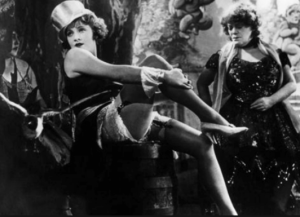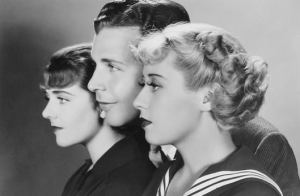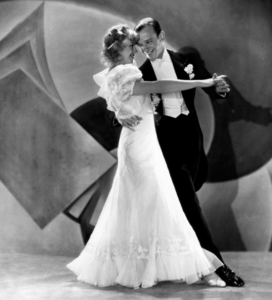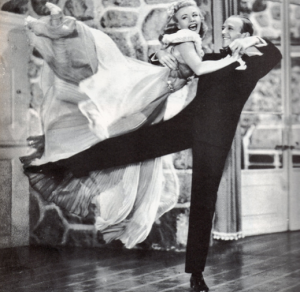The cinema of the 1930s was dominated by bold, elegant, and beautiful musicals. A.D. Cooper gives us a history of some of the most popular musical filmmakers and stars of the turbulent decade.
Looking back at the stylish musicals of the 1930s, it’s easy to imagine that the films reflect the zeitgeist of the decade. In fact, they could not have been further away from it.
Turbulent times
The 1930s was an era of political and social turmoil combined with grinding poverty from a persistent worldwide depression. World War 1 still cast a long shadow, ensuring that millions of women would never be able to marry for lack of men. They often went to the new “talkies” in groups. Cinema was hugely popular as everyone sought escape from their meagre lot in the romance and glamour of films.
The British did produce a few musical films in during this time, but the majority of the most successful films were American. The Jazz Singer (1928) was the world’s first talking movie included popular singer Al Jolson belting out songs, and the studios soon realized the potential for a whole new genre.
During the 1930s, around 400 musicals and musical films were presented, with successful stage shows adapted for films including the world-famous Ziegfeld Follies. Many of the top stars, jazz and swing performers were soon appearing in films – Duke Ellington, Cab Calloway, Ethel Merman, Marlene Dietrich and many more.
All singing, all dancing
Two styles of musical stand out from the crowd as typifying the 1930s.
The first are Busby Berkley musicals. Originally a stage choreographer of Broadway musicals, Berkley quickly found his way to Hollywood and directed the dance sequences in a string of hugely successful musical films.
These films often portrayed the production of a theatre show to give context to the epic music numbers. This balanced the glitz, beauty and glamour with the harsh reality of the world back stage and outside the theatre. One song “My Forgotten Man” even referenced the sacrifice of American soldiers in the Great War.
Berkley’s films always featured thousands of beautiful girls. These waltzed, tap-danced and swam often whilst singing and wearing spangled and surprisingly revealing costumes. They were often turned into moving human kaleidoscopic and geometric patterns.
Berkley’s trademark extravagant aerials shots were combined with quick takes and close-ups on particular areas of the body (some of which were cause outrage amongst the moral guardians of the era). This was dance as spectacle.
Berkley was a slave-driving perfectionist, but much in demand. He’s credited with choreographing and/or directing 23 films between 1930 and 1939. Most famously he’s remembered for 42nd Street, Dames, Footlight Parade, and the trio of Gold Diggers of 1933, 1935 and 1937. These films usually featured a proven troupe that included Ruby Keeler, not a great singer or actor but a great dancer (and Mrs Al Jolson), matinee idol Dick Powell, Joan Blondell (“the blonde bombshell”) with appearances by Ginger Rogers and James Cagney, both incredible tap dancers. The musical numbers were often written by leading duo Warren & Dubin songs.
Fred & Ginger
Fred Astaire and Ginger Rogers were the glamorous image of the 1930s, and featured in a series of incredibly successful musicals for RKO Pictures.
The scripts are droll, flimsy love stories, perhaps somewhat old fashioned now, but the musical/dance numbers are an integral part of the plot development.
There is no hint of the gritty 1930s reality to contrast the glamour as in Busby Berkley’s films. In a Fred & Ginger films, everything shouted style and glamour, wealth and sophistication, including the sleek Art Deco-inspired sets and the gleaming black dance floors. The bill from the costume department must have been immense, with a huge wardrobe of bias-cut satin evening dresses, furs, hats and jewels for Ginger, with Fred effortlessly debonair in top hat, white tie and tails or a sharp tuxedo.
Astaire had already proven himself on stage around the world as an extraordinary tap dancer during the 1920s partnering his sister Adele. When she married and retired from the business, Fred went solo. Hollywood came calling but success wasn’t immediate. In a screen test, the film producer noted that Fred was “balding, skinny and can dance a little”.
Fred first appeared on screen in a small role paired with Ginger in Flying down to Rio starring Dolores Del Rio. Their on-screen chemistry was noticed during their dance numbers, and they were quickly given a string of starring roles: Top Hat (1935) The Gay Divorcée (1934), Swing Time, Follow the fleet (1936), Shall we dance? (1937), Carefree (1937), The story of Vernon & Irene Castle (1939) and Roberta with music by Jerome Kern.
And boy could they dance. The music would fade up, prompting Fred and Ginger to glide elegantly into a tap routine usually choreographed by Fred or in collaboration with Hèrmes Pan. What’s more, the musical numbers were by Cole Porter, Irving Berlin and Gershwin amongst others.
Fred tended to get most of the attention, but Ginger pointed out that she did everything he did, only backwards, and all while wearing high heels! Fred was a perfectionist, rehearsing for long hours to get the right performance, then filming often in one take from a single stationary camera. Fred famously declared “Either the camera will dance, or I will”. By the time the number was in the can, Ginger’s feet would often be bleeding.
Fred and Ginger became generic for style and glamour on the dance floor. They were very different personalities and came from very different backgrounds, and the on-screen chemistry never extended to off-screen romance. But as Katherine Hepburn remarked “He gave her class and she gave him sex appeal”.
Making way for colour
By the time the 1930s ended, war had broken out and cinema had never been more vital for providing escapism. The development of colour film photography also increased the potential spectacle of the big song and dance numbers that would be seen in the 1940s and 1950s. But the decade ended with one of the all-time great musicals The Wizard of Oz.








It is my impression that Nelson Eddy and Jeanette MacDonald were a more popular
pair in the 1930s than Astaire and Rogers..I know that such is not the case
today, but in the early 40s, I was very much aware that Nelson Eddy and Jeanette
MacDonald had been a famous movie pair in 1930s. Though I was also much aware
of Fred Astaire and Ginger Rogers,I had no idea that they had been a famous pair
in the 1930s; in fact as famous as Ginger Rogers was, I had no idea she had been
a dancer